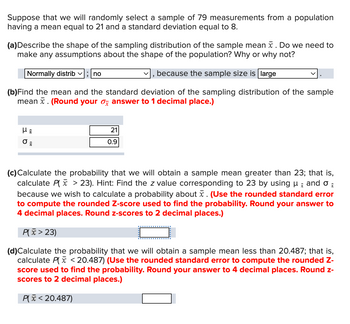having a mean equal to 21 and a standard deviation equal to 8. (a) Describe the shape of the sampling distribution of the sample mean x . Do we need to make any assumptions about the shape of the population? Why or why not? Normally distributed because the sample size is large (b)Find the mean and the standard deviation of the sampling distribution of the sample mean x. (Round your answer to 1 decimal place.) O no
having a mean equal to 21 and a standard deviation equal to 8. (a) Describe the shape of the sampling distribution of the sample mean x . Do we need to make any assumptions about the shape of the population? Why or why not? Normally distributed because the sample size is large (b)Find the mean and the standard deviation of the sampling distribution of the sample mean x. (Round your answer to 1 decimal place.) O no
Glencoe Algebra 1, Student Edition, 9780079039897, 0079039898, 2018
18th Edition
ISBN:9780079039897
Author:Carter
Publisher:Carter
Chapter10: Statistics
Section: Chapter Questions
Problem 22SGR
Related questions
Question
100%

Transcribed Image Text:Suppose that we will randomly select a sample of 79 measurements from a population
having a mean equal to 21 and a standard deviation equal to 8.
(a)Describe the shape of the sampling distribution of the sample mean x . Do we need to
make any assumptions about the shape of the population? Why or why not?
Normally distributed
because the sample size is large
(b)Find the mean and the standard deviation of the sampling distribution of the sample
meanx. (Round your answer to 1 decimal place.)
no
Expert Solution
This question has been solved!
Explore an expertly crafted, step-by-step solution for a thorough understanding of key concepts.
Step by step
Solved in 3 steps

Follow-up Questions
Read through expert solutions to related follow-up questions below.
Follow-up Question

Transcribed Image Text:Suppose that we will randomly select a sample of 79 measurements from a population
having a mean equal to 21 and a standard deviation equal to 8.
(a)Describe the shape of the sampling distribution of the sample mean . Do we need to
make any assumptions about the shape of the population? Why or why not?
Normally distrib; no
because the sample size is large
(b) Find the mean and the standard deviation of the sampling distribution of the sample
mean . (Round your answer to 1 decimal place.)
O
8
21
0.9
"
X
(c) Calculate the probability that we will obtain a sample mean greater than 23; that is,
calculate P(x > 23). Hint: Find the z value corresponding to 23 by using µ and o
because we wish to calculate a probability about . (Use the rounded standard error
to compute the rounded Z-score used to find the probability. Round your answer to
4 decimal places. Round z-scores to 2 decimal places.)
P(x>23)
(d)Calculate the probability that we will obtain a sample mean less than 20.487; that is,
calculate P(x < 20.487) (Use the rounded standard error to compute the rounded Z-
score used to find the probability. Round your answer to 4 decimal places. Round z-
scores to 2 decimal places.)
P(x < 20.487)
Solution
Recommended textbooks for you

Glencoe Algebra 1, Student Edition, 9780079039897…
Algebra
ISBN:
9780079039897
Author:
Carter
Publisher:
McGraw Hill

Big Ideas Math A Bridge To Success Algebra 1: Stu…
Algebra
ISBN:
9781680331141
Author:
HOUGHTON MIFFLIN HARCOURT
Publisher:
Houghton Mifflin Harcourt

Glencoe Algebra 1, Student Edition, 9780079039897…
Algebra
ISBN:
9780079039897
Author:
Carter
Publisher:
McGraw Hill

Big Ideas Math A Bridge To Success Algebra 1: Stu…
Algebra
ISBN:
9781680331141
Author:
HOUGHTON MIFFLIN HARCOURT
Publisher:
Houghton Mifflin Harcourt